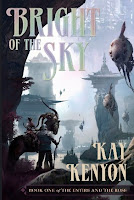Here’s my “final” schedule for the 66th World Science Fiction Convention, Denver, Colorado, August 6th to 10th:
Wednesday 2:30 PM
33 Cover Art in the Internet Age
CCC – Korbel 4CD
“Don’t judge a book by its cover.” How does this maxim work in the internet age when books are sold online (with small images of the cover) or even more so in e-books.
John Picacio, (m)Laura Givens, Lou Anders
Wednesday 4pm
57 Signing (75 minutes)
CCC – Hall D
Cynthia Felice, Lawrence Watt-Evans, Lou Anders, Mike Resnick, Warren Hammond
Friday 9AM
Stroll With the Stars
A gentle, friendly 1 mile stroll with some of your favorite Authors, Artists & Editors. Leaving daily. 9AM, from the Big Blue Bear in front of the Colorado Convention Center,
returning before other Programming begins, definitely before 10.
Lou Anders, Paul Cornell, John Picacio, Stephen H. Segal
Friday 11:30 AM
304 Kaffeeklatsch
CCC – Korbel 4E
Elizabeth Moon, James Patrick Kelly, Joe Haldeman, Lou Anders
Friday 5:30 PM
416 Pyr Books Presentation
CCC – Korbel 4CD
Lou Anders & authors and artists
Friday 8Pm – 11PM
Sheraton Party Floor
Pyr Party in Honor of Ian McDonald
Saturday 10AM
455 The Comeback of Original Anthology Collections
CCC – Korbel 1C
New collections of original stories are appearing more frequently now than over the recent past. Original Anthology Collections may be substituting for or supplementing magazines as a market for short fiction. Why are we seeing this and what can we expect in the near future?
Ellen Datlow, Jonathan Strahan, (m)Lee Martindale, Lou Anders
Sunday 1pm
655 The Coming Thing – what’s next and newest in SF
CCC – Room 502
Panelists discuss what is next up in the SF pipeline.
What new crazy ideas and approaches should we be looking for? What’s going to be popular next year, and after that?
Charles Stross, (m)Daniel Abraham, Lou Anders





